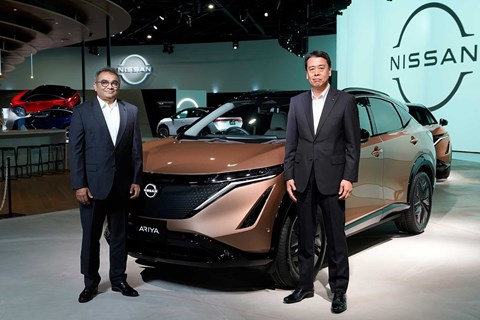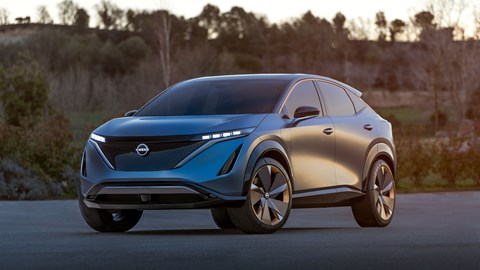► We interview Ashwani Gupta, Nissan COO
► Nissan’s recovery plans in the post-Ghosn era
► EVs, Europe, SUVs… but no Z sports car for Europe
Is Nissan pulling out of Europe? Ashwani Gupta, Nissan’s global chief operating officer, says not. ‘Europe is a very important market for us,’ he stresses. But – and this is a critical distinction – it’s not a ‘core’ market, rubbing tectonic plates with China, Japan and the United States.
That’s partly because Europe has pulled out of Nissans. In 2017, the region registered 566,191 cars from the brand whose Qashqai and Juke popularised the crossover. Two years on, sales slumped to 394,091, in a stable, pre-coronavirus market.
The Juke’s life cycle was stretched to nine years before replacement, while frugal new engines took too long to reach the Qashqai; still neither comes as a hybrid. Both were exposed as rival manufacturers piled in with fresher models.
Nissan’s problems haven’t been confined to Europe, as former CEO Carlos Ghosn’s expansionist era came crashing down. It targeted eight per cent global market share at an eight per cent margin – in the last financial year, Nissan had 5.8 per cent market share, and booked a ¥40 billion (about £300 million) operating loss, with much more in restructuring costs.
Further reading: the rise and fall of Carlos Ghosn
‘We went too fast to expand in the world, anticipating that global auto markets would grow and that our sales performance would be excellent. Both those things didn’t happen,’ says Gupta, an engineering graduate turned operations expert. ‘When rubber touches the ground you smell the smoke.

‘As a result we were landed with aged vehicles, a huge line-up which we could not maintain. It’s all based on investment: if you don’t have the revenue you can’t have [new] cars. It’s a vicious cycle. So what Nissan said is: let’s rationalise.’
The result is the Nissan Next turnaround plan, which has 50-year-old Gupta’s fingerprints all over it as the firm’s chief performance overseer. It sets Nissan’s targets out to 2023: cutting costs, closing plants in Spain and Indonesia, discontinuing models including the entire Datsun range in Russia, and working more closely with alliance partner Renault. In short, Nissan is cutting its cloth to fit its diminished stature.
The rationalisation plan came from interrogating Nissan’s potential in every market. ‘When you tick those boxes, the US, China, Japan are our biggest markets. In the US, our market share is more than seven per cent, in Japan and China it’s more than 10 per cent. Profit? Yes in China and Japan, and in the US we think we have a potential to make [it].’
Gupta is no stranger to Europe, having been to university in Southampton and Sheffield, and living in Paris for eight years working for the Alliance. He praises the ‘great’ Sunderland plant – long-caught in the Brexit crosshairs – which churns out Nissan’s crossovers, then there’s the Bedfordshire engineering centre that helped birth the ground-breaking Qashqai. Great infrastructure, but not enough to elevate Europe to core status.
‘Total industry volume is 15 million. That’s not a small market. But our share is 2.5 per cent. We can’t do everything, so we will focus on our strengths. In Europe that’s crossovers: Qashqai, Juke, X-Trail. Then in terms of technology, we go with electric, autonomous and connected.’

Three crucial new models will arrive in the next year or so: the third Qashqai, the seven-seat X-Trail and the tantalising, all-electric Ariya (above), a model that really kicks on from the Leaf.
By 2023, half of all Nissans sold in Europe will be electrified: ePower range-extender hybrid tech, where a small petrol engine acts solely as a generator, will be fitted to the next Qashqai for starters. And the X-Trail shares its plug-in-hybrid basis with Mitsubishi’s new Outlander.
But the lack of low-emissions technology on the next-generation Z sports car means it won’t come here. ‘Europe is the market which challenges us on technology, especially regarding the environment,’ admits the COO. Nissan currently sells around 500 Z cars in Europe a year – similar numbers to Japan – but the forthcoming twin-turbo V6 is very much aimed at America, which delivers four to six times that volume.
As for the Micra, any future model will be far more closely related to the Clio, due to Renault-Nissan’s leader/follower development strategy. Nissan will focus on EVs, sports cars and larger models, with Renault leading the B-segment and vans.
‘We don’t have the strength to invest,’ says Gupta, ‘so we’re asking Renault because it is strong in these segments. This is what we mean by prioritisation and focus.’ All in the name of bagging six per cent global market share in three years’ time – and getting Nissan standing tall again.
Six questions only we would ask
Tell us about your first car
‘A restored Willys Jeep — it rode like butter even on the craziest of terrain.’
What is your proudest achievement?
‘Hitting big milestones thanks to a team effort.’
Tell us about a time you screwed up?
‘I’ve definitely had my fair share of screw-ups; I see them as doors opening to success. It’s definitely important to learn from them to move forward.’
Best thing you’ve ever done in a car?
‘Lift-off oversteer in my Jeep; again with a GT-R on an airstrip in Newport Beach.’
Supercar or classic car?
‘Classic cars will always be classic. However, for me, supercars all the way! The GT-R will always be my first love.’
Curveball… what electric or e-4orce tech will inform your next sports cars?
[Laughs] ‘It’s too early for me to share with you, but we are working on the next Z.’